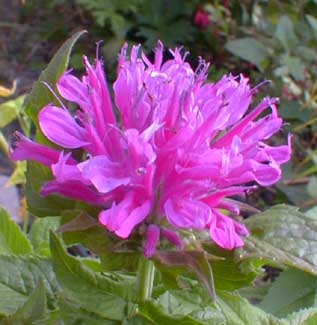
'Petite Wonder'
Beebalm or Bergamot
"Speak not -- whisper not;
Here bloweth thyme & bergamot;
Softly on the evening hour,
Secret herbs their spices shower."
-Walter de la Mare
(1873-1958)
(1873-1958)
Though beebalm has become the most commonly used common name for the North American wildflower Monarda, it is also well known as Bergamot or Oswego tea.
The cultivar Monarda x didyma 'Petite Wonder' was developed at the Morden Research Station in Manitoba, & introduced to American gardeners by Bailey Nursery of Minnesota on the cusp of the new millenium. I believe 'Petite wonder' arose like many beebalm cultivars from M. didyma pollinated by M. fistulosa, though I have not found a good chronicle of how it was bred.
The bright pink 'Petite Wonder' & lavender-rose 'Petite Delight' were the first two true dwarf beebalms. 'Petite Wonder' is the smallest of the two, at ten to fifteen inches height, slowly spreading eighteen inches to two feet wide, divisible in spring or autumn. It has none of the invasive propensities of many other mint family herbs including wild bergamot.
'Petite Wonder' blooms from mid-summer until early autumn, with just about the pinkest of any flower within the genus. Most beebalms have a circular "crown" of rosettes that make the blossoms instantly recognizable as beebalm, but the bent florets are very subdued on 'Petite Wonder' so that its almost a pompom.
The aromatic foliage of 'Petite Wonder' is a very dark green with maroon highlights, more densely leafed than full-sized monardas.
Beebalms are liked by butterflies, hummingbirds, & honeybees. They prefer full sun or very little afternoon shade, in humusy soil, moist but well draining. Long established clumps can be somewhat drought resistant though they perform best if the don't experience droughtiness or sogginess either one.
It is moderately resistant to that bane of beebalms, powdery mildew, although it does require an airy position with good air circulation to be sure it remains unafflicted. If it experiences droughtiness, overcrowding, or is situated near sprayed irrigation so that its leaves are constantly wetted, it's resistance to powdery mildew is not nearly as reliable.